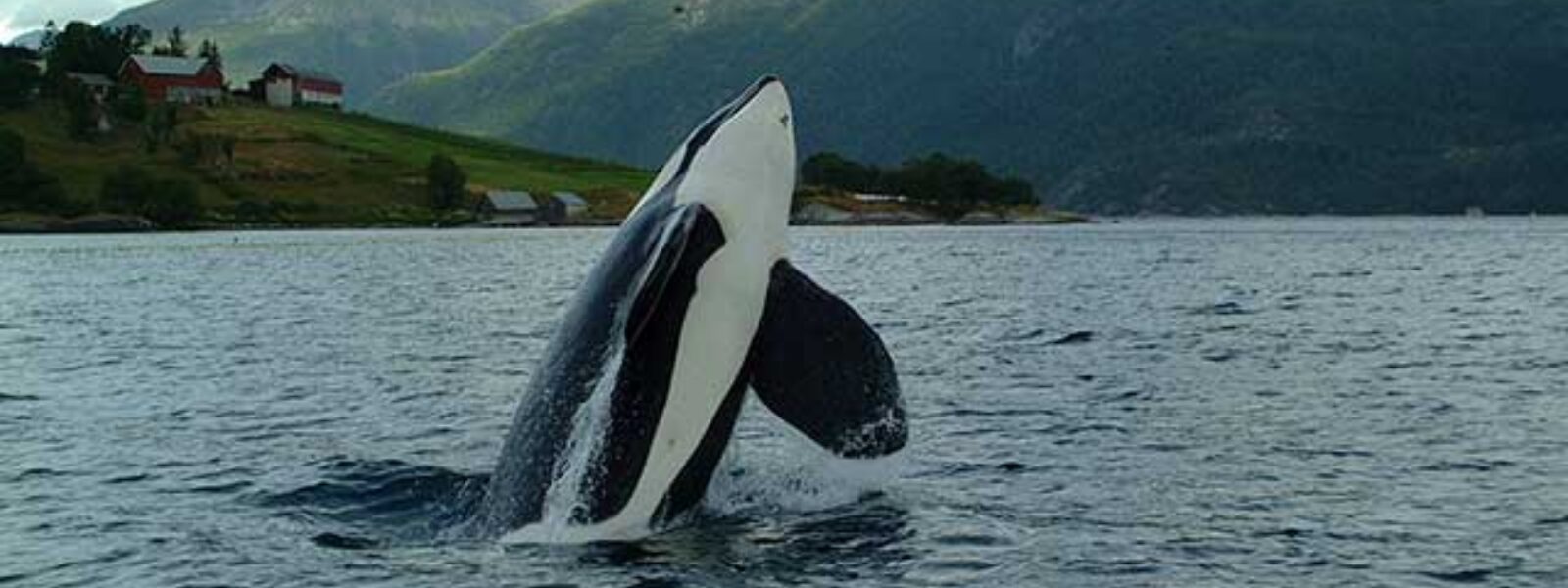
“Free Willy” Paved the Way to Ending Whale Captivity
Full Essay
By Hannah Hindley
Hannah Hindley is a naturalist, science writer, and conservationist. She is a recipient of the Barry Lopez Prize in Nonfiction, the Ellen Meloy Desert Writers Award, and the Thomas Wood Award in Journalism, among other honors – see more of her work at hannahhindley.com. She often spends summers among the wild whales in Alaska, working as a wilderness guide.
THE FIRST LEAP
On the movie poster, water takes up the lower two thirds of the frame, dark and sparkling. Above it, standing atop a stony breakwater, a boy stands with one arm raised high, and above him – with a muscular body that fills the sky – an enormous orca breaches toward the open sea.
If you lived through the 90s, you likely watched Free Willy or have watched it more recently on streaming services or DVD. Nearly 9 million copies of the Free Willy video cassette were sold to an adoring movie viewership, reaching over one hundred million people.
Free Willy is the story of an orphan boy befriending, and eventually liberating, a captive orca at a run-down amusement park. When the International Marine Mammal Project (IMMP) of Earth Island Institute suggested to Warner Brothers Producers Dick Donner and Lauren Shuler-Donner that IMMP’s toll-free number – 1-800-4-WHALES – be put at the end of the blockbuster hit, the IMMP team had no idea that the phone would ring off the hook with hundreds of thousands of callers, interested not just in the plight of whales at large, but specifically in the plight of the real-life “actor” who played Willy: a captive orca named Keiko.
When movie viewers discovered that Keiko was still in captivity, IMMP found itself at the center of an unprecedented – and as-yet unreplicated – campaign to free a captive orca. As heartwarming and simple as the movie poster made it seem, the real story that follows was far knottier and more elaborate than any Hollywood plot.
Thirty years after the release of the film, we pause to look back on its impact, and forward to the future of all whales and dolphins still in captivity, in our metaphorical backyards and around the globe.
KEIKO
When Dave Phillips, the founder and director of IMMP, first met Keiko, he sat alone in the empty bleachers of a theme park in Mexico, looking down at the tiny tank where the orca floated. The distant sound of traffic growled, but the lethargic whale below made no sound; he had stopped vocalizing many years before. Keiko hadn’t been born in captivity – his life had begun in Iceland’s cold and luminous sea. He swam with his wild family, following his mother through the flurries of schools of fish and diving birds, learning the dialect of his pod, diving through prismatic green currents. When he was captured as a two-year-old calf by a commercial herring trawler, he lost this world.
His dorsal fin – which should have stood taller than a grown man – drooped. Infection bloomed across his skin.
Keiko’s captors brought him to a small Icelandic aquarium, and from there he was sold to a marine park, MarineLand, in Ontario, where larger captive killer whales slapped and bumped him against the walls of his concrete tank. From there he was sold again, and transported by airplane across international borders to Mexico City, where he breathed strange high-altitude smog, ate warm fish, and ground his sharp teeth flat from gnawing at the edges of his too-small tank.
His dorsal fin – which should have stood taller than a grown man – drooped. Infection bloomed across his skin. If the directors of Free Willy (in search of a trained orca and finding little luck convincing US theme parks to loan them any of theirs’) hadn’t found him and launched him to stardom, he would have died in this concrete prison, possibly quite soon after Free Willy was released. Keiko was severely underweight, and his health was declining quickly.
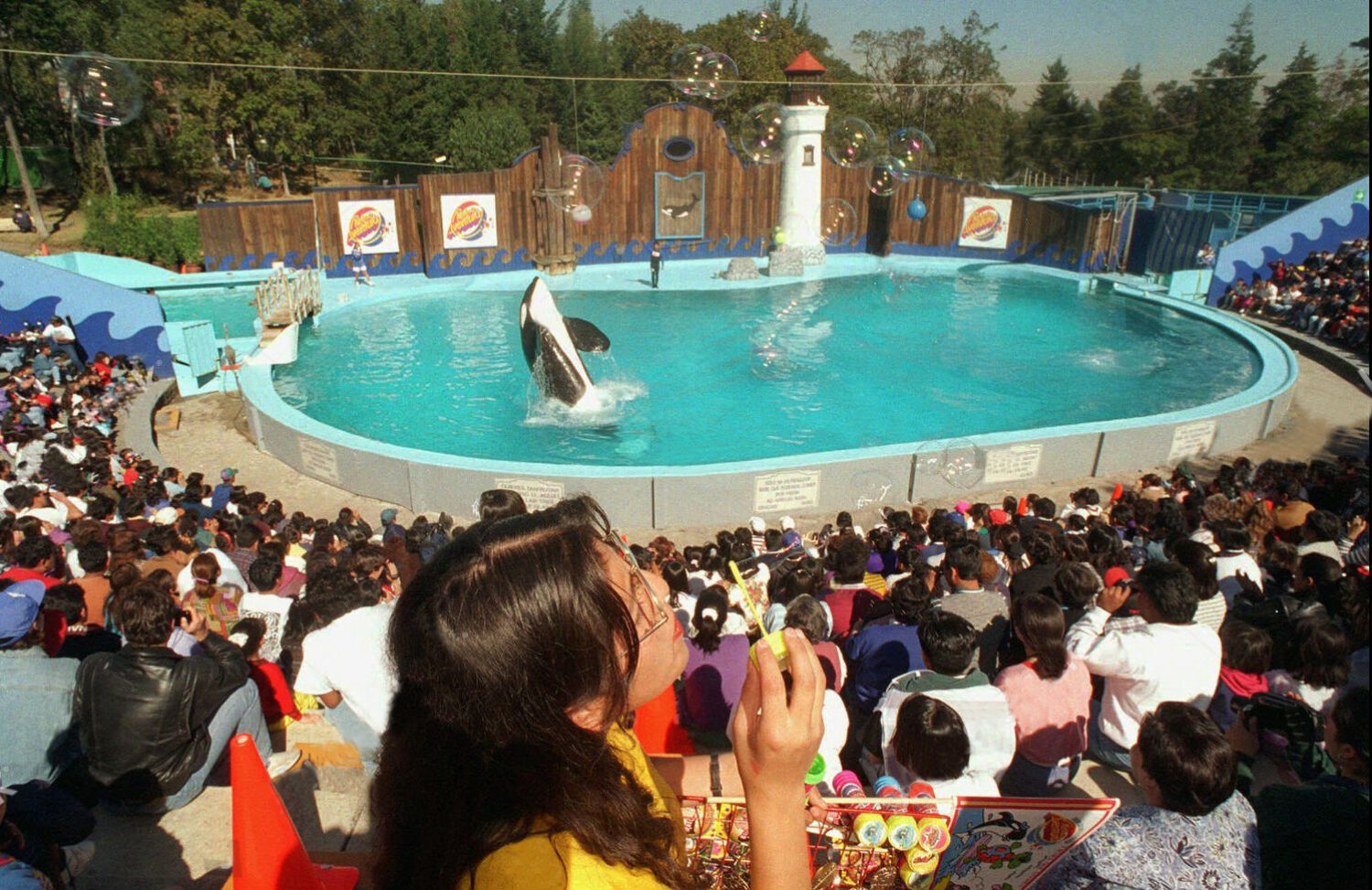
Photo Credit: IMMP
Keiko in Mexico's Reino Adventura Park. Photo Credit: Free Willy/Keiko Foundation
As soon as the movie was released, IMMP’s 800-number at the end of Free Willy began flooding with calls, and Warner Bros. was in the spotlight too. Viewers wanted to know if the real Willy was free, and when they learned the answer, they demanded justice. Director Dick Donner called Dave urging the IMMP team to take on the rescue of Keiko.
At first there was reticence as Dave asked Dick: “You do know we’re in the business of wild whales, right?”. Dick was not to be deterred. “Just go down there; check it out. You can do this!” Under mounting pressure to do something and his own concern for the orca, Dave found himself on a flight to Mexico City.
“Keiko,” he said, “we’re taking you home.”
Sitting above Keiko’s concrete tank, Dave didn’t expect to be so moved by the enormous figure drifting listlessly below him – a highly social animal alone in a small concrete prison. Warm water sloshed against the edge of the enclosure. The infections under Keiko’s fins were cracked and raw. While the streets of Mexico City rumbled nearby, Dave pulled out a yellow notepad and tried to calculate what it would take to relocate Keiko, bring him back to health, and give him a chance to be free. The project seemed to be such a long shot and insurmountably expensive. But he thought back to all the voicemails left on the 800 hotline and all the conversations he’d had leading up to his flight. Everyone he spoke with told him the same thing: “If you take this on, we’ll help.”
And so IMMP took the leap. Dave assembled a team of experts and the IMMP staff, including long-time captive whale advocate Mark Berman, to incorporate the Free Willy/Keiko Foundation to raise the funds and take possession of Keiko, generously donated by Mexico City’s Reino Aventura park, where Free Willy had been filmed.
And sure enough, help came. More than $7 million in donations rolled in from Keiko’s friends around the world. IMMP joined forces with Warner Brothers, telecommunications billionaire Craig McCaw and his then wife, Wendy McCaw, and the Humane Society of the US. Later, the Ocean Futures Society took on a key role and helped immensely.
But the “leap” wasn’t as easy as the poster made it look. No one had ever attempted anything like this before. From convincing the owners of Keiko to donate him to the Free Willy / Keiko Foundation; to convincing the president of Iceland – a whaling nation – to accept Keiko back into his home waters; from transporting Keiko to a custom-built seawater rescue center in Oregon; to teaching him to hunt for live fish; the route from that tiny tank in the mountains of Mexico back to Keiko’s home waters was far more circuitous than the plot of any movie.
In an extraordinary crowning act of goodwill, the top brass and pilots of the US Air Force unanimously agreed to provide the only jet in the world that could fly nonstop from a small airport in Oregon to a short airstrip off the coast of Iceland for Keiko’s final journey home.
In this way, Keiko, his care team, and Dave flew 40,000 feet above the ocean: Dave strapped into a fold-down seat; Keiko suspended by a sling in water and ice. Once again, just like that first fateful day in Mexico, Dave found himself sitting, watching an amazing 11,000-pound sentient animal in his transport box . . . but this time Keiko was surrounded by friends. Dave got a chance to unbuckle from his seat and climb up next to Keiko on that flight, and speak to him.
“Keiko,” he said, “we’re taking you home.”
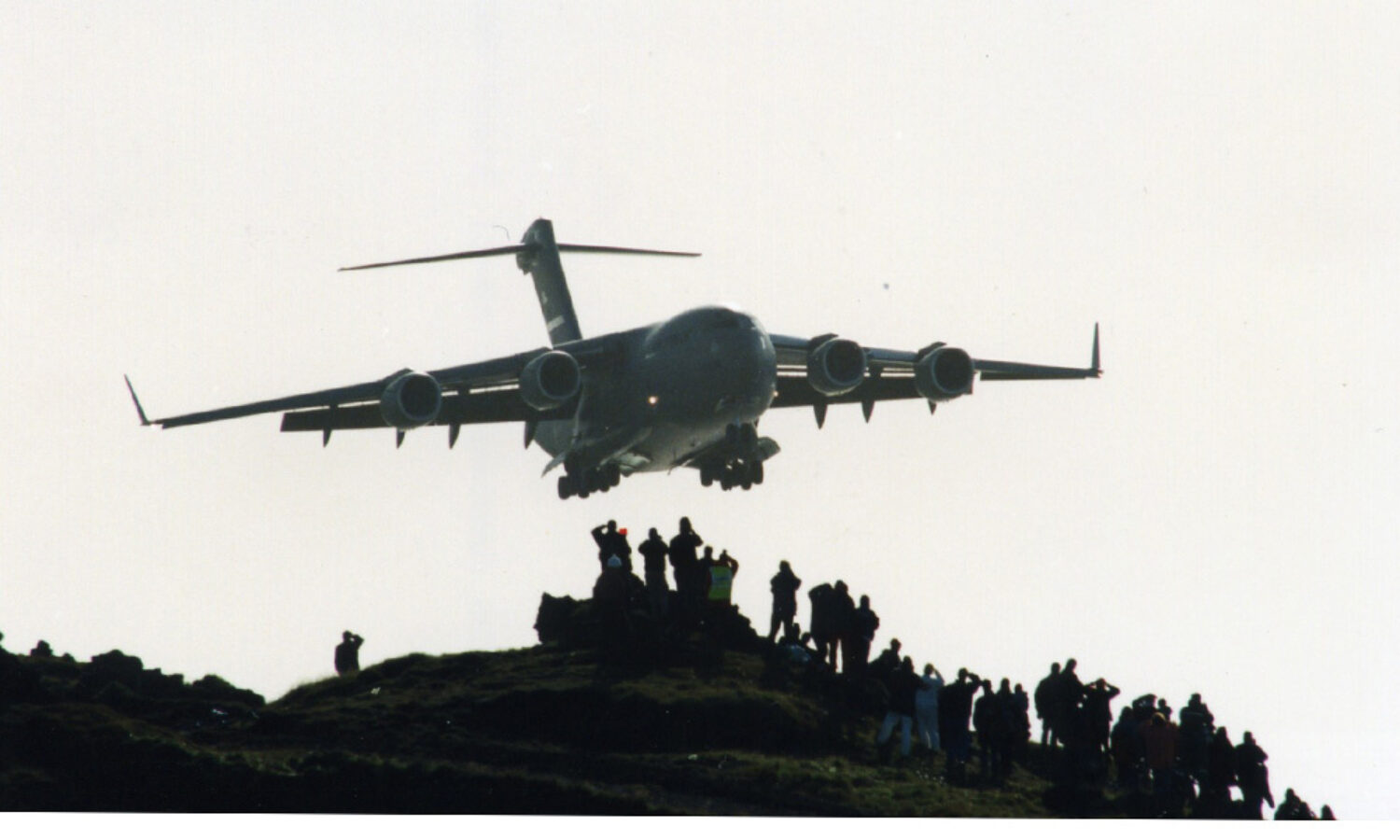
Keiko Arrives in Iceland. Photo Credit: Free Willy/Keiko Foundation
BLACKFISH
Inside an MRI scanner, vibrating radio waves reveal a hidden world that we could only guess at when Free Willy was filmed. In the years following the movie’s release, scientists have unveiled mesmerizing complexities in the minds of cetaceans.
Humans and orcas both have the same emotional center in our brains, called the limbic system, but orcas have a whole extra lobe connected to their limbic system – suggesting that their emotional capacity and social bonds might be more sophisticated than the human brain can even comprehend. These neurological discoveries aren’t unique to orcas. Dolphins have a third again as many folds in their brain as humans do (the larger the brain’s surface area, the more specialized functions it can support). Belugas have one of the most complex neocortices on Earth – more intricate, even, than that of humans. This is the part of the brain involved in high-level cognition like problem-solving and self-awareness.
We continue to document cases where whales and dolphins save the lives of humans and other animals – acts of altruism across species lines that behavioral scientists still cannot explain.
We continue to document cases where whales and dolphins save the lives of humans and other animals – acts of altruism across species lines that behavioral scientists still cannot explain. We’ve begun to understand the ways that intricate humpback whale songs evolve, the ways that orcas teach dialect to their young, and the ways that sperm whales use distinct sounds, called codas, to identify each other “by name.”
For too long a time, we distinguished ourselves as the only animals to have spindle neurons: structures in the brain that are responsible for high-level communication, adaptive thinking, memory, and perception. We know now that whales, too, have spindle neurons in their brains. And the most compelling connection of all: these specialized neurons are what allow us – humans and whales alike – to love, and also to suffer.
On the tail of these discoveries, twenty years after Free Willy first screened in theaters, the documentary Blackfish took the latest cetacean neuroscience and challenged the idea that these animals should be kept in captivity. We know now that orcas are highly social, staggeringly emotionally evolved animals with brains that can feel suffering similar to ours. And we’ve seen how captivity affects them – ranging from violence (as in the case of Blackfish’s poster child Tilikum, a captive orca at SeaWorld that was involved in the deaths of three people) to depression.
California passed IMMP-supported legislation banning orca breeding and performances in the state, and eventually, thanks in part to campaign work by IMMP and other organizations, SeaWorld agreed to end all orca breeding and importations at their facilities.
If we know these things, wondered the audiences of Blackfish, how can we still allow these enormous sentient beings to be isolated and confined? As with Free Willy, phones rang off the hook. IMMP made presentations at screenings of Blackfish, urging the audience to take action to help captive whales and dolphins.
Change came slowly, but now the term “Blackfish Effect” is used to describe the disastrous impact well-made media can have on the indomitable powers that be. Blackfish was accompanied by action. SeaWorld’s stock collapsed, audiences pressured Southwest Airlines to null their 25-year partnership with the amusement park, and SeaWorld was forced to pay $65 million for lying to investors about the impact Blackfish had on its finances. Former SeaWorld trainers continued to assail the company for their inhumane practices. California passed IMMP-supported legislation banning orca breeding and performances in the state, and eventually, thanks in part to campaign work by IMMP and other organizations, SeaWorld agreed to end all orca breeding and importations at their facilities.
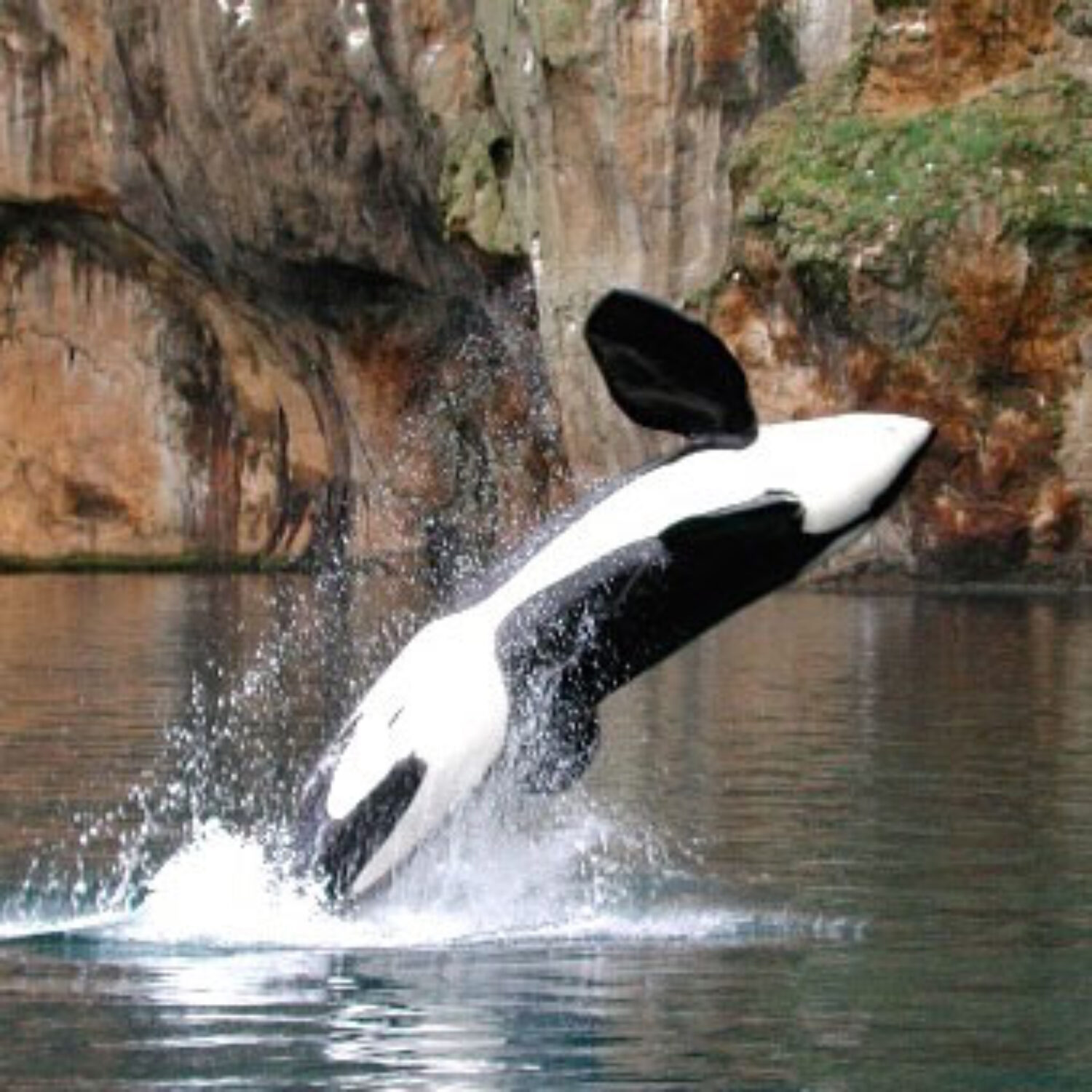
Keiko Breaching in His Seaside Sanctuary in Iceland. Photo Credit: Free Willy/Keiko Foundation
Still, orcas perform at their parks. At SeaWorld’s three US parks alone, 18 orcas – whose lives, at least in the wild, can be as long as 80 years – remain in concrete tanks. These whales suffer from stress, boredom, abnormal and aggressive behaviors, compromised health and premature death, yet SeaWorld refuses to allow for retirement of any of the orcas they hold in captivity.
Globally, there are at least 50 orcas in captivity.
SeaWorld argues that releasing animals that have spent so long in captivity would be a death sentence (Keiko died of pneumonia five years after his return to his home waters in Iceland), despite experience from Keiko and other cetaceans that retiring captive orcas to seaside sanctuaries would greatly increase their quality of life and longevity. With every passing day it becomes clearer that SeaWorld’s motivation is to derive the maximum profit from exploiting orcas and dolphins for the rest of their lives.
Globally, there are at least 50 orcas in captivity, and more continue to be bred and captured, although a coalition of international organizations and grassroots Russian groups, coordinated by IMMP staff, has temporarily blocked captures of wild orcas in the Sea of Okhotsk, the only recent area where orcas have been trapped for captivity. In the face of worldwide outrage at the mass captures, the Russian government released ten orcas and 87 beluga whales, from temporary holding pens in the notorious Whale Jail, back to their ocean home – they’d been captured to be sold to aquariums in China. More than 300 belugas are kept still captive, and more than 1000 bottlenose dolphins. All told, over 3000 cetaceans live in captivity now, across all species.
Three thousand minds; three thousand caged bodies. We know too much about the interior lives and intellect of these animals for this to stand. All cetaceans deserve freedom.
When the jet plane transporting Keiko, the orca star of Free Willy, touched down in Iceland all those years ago, Dave Phillips looked out the window. Dawn was rising, and as the plane descended, he could see, lining the hills below, hundreds of children standing in the first light, holding up signs that read “welcome home.” Triumph – and hope, too – were palpable in the early morning air.
Keiko was the first captive orca whale to be released back into wild waters. What will history say of us, if he remains the only one?
SANCTUARY / THE FINAL CHAPTER
When Warner Bros. began fielding agitated phone calls after the release of Free Willy, Keiko’s friends from around the world began offering solutions. One little girl, in particular, had an exceptional idea: she wrote from Nova Scotia, where her family lived on the shores of “a beautiful, deep, sheltered cove” – a perfect refuge for a recovering whale. Corinne Goyetche used a green pencil to scrawl commentary across maps, depth charts, fisheries data, and freshwater discharge tables, all of which she mailed off to IMMP and the Free Willy/Keiko Foundation. Liberating a captive whale was complicated business.
But rather than Nova Scotia, Keiko made it all the way to his home in the wild waters of Iceland.
Corinne’s idea had true merit. Keiko spent about three years living in a cove in Iceland’s Westman Islands in a seaside sanctuary netted off from the ocean, very similar to Corinne’s idea. He was fed and received veterinary care. He was taught to follow a guide boat on “walks” out on the open ocean, to swim with wild orca pods.
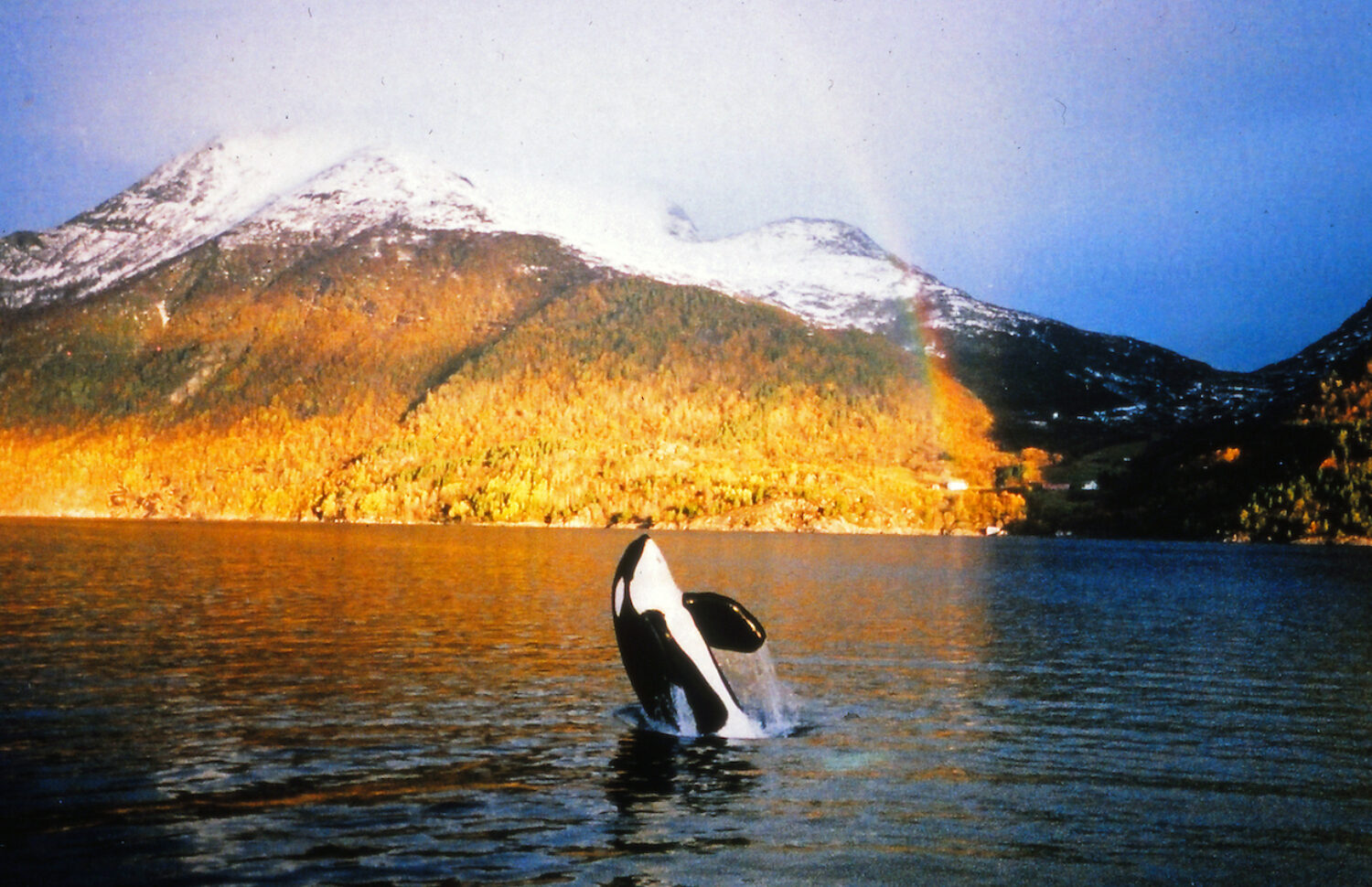
Keiko in Norway. Photo by Mark Berman, Free Willy/Keiko Foundation
And eventually, he swam free.
Today, seaside sanctuaries might be the solution that finally cracks the dilemma of how to safely and humanely give freedom to the world’s captive whales. Think of it as a retirement plan: healthy dolphins and whales that were captured from the wild have the chance to be fully released into their wild home waters. Those born in captivity or contending with health issues leaving them little chance of being able to feed themselves or survive the rigors of open water shouldn’t be left behind either. A netted-off bay, with veterinary care and food provided, would allow animals the chance to live out their lives in freedom rather than in tanks – to be able to feel the rise and fall of the tides, to dive deep into strong, cold currents . . . possibly even to hear the voices of long-lost families in the ocean beyond.
What was once thought impossible is now within reach.
It’s more than an optimistic idea. The tide is turning. In 2020, in the very same bay where Keiko was first returned to Iceland, two beluga whales named Little White and Little Gray made history as the first belugas to be freed from a concrete tank. Their sea pen in Klettsvik Bay serves as a model for rehoming the other 300 belugas currently in tanks. Other sea sanctuaries are being created elsewhere, too: the Whale Sanctuary Project, co-founded by Dave Phillips, seeks to provide freed whales an enclosed part of the ocean in Nova Scotia, far bigger than the world’s biggest aquarium. In Greece, the Aegean Marine Life Sanctuary will soon become the first permanent sanctuary for warm-water dolphins in the world. All that remains is to call for an end to captivity.
Momentum is building. In March, the Miami Seaquarium made a historic announcement that they would be returning the 56-year-old orca Lolita – also known as Tokitae – to an undisclosed sea sanctuary in her home waters of the Pacific Northwest. Public interest continues to build, too – coming soon, the award-winning podcast Serial plans to tell the story of Keiko, 30 years after Free Willy. Another good source is the documentary Keiko, the Untold Story of the Star of Free Willy, available to rent or buy . Believers in whale sovereignty continue to push Congress to pass the SWIMS Act, a federal law endorsed by IMMP, which would phase out captivity in the US of orcas, belugas, pilot whales and false killer whales by banning imports, exports, and breeding in captivity.
As public and political sentiment shift, Dave Phillips thinks we might truly be close to ending whale captivity forever: “What was once thought impossible,” he says, “is now within reach.”
Thirty years later, people still call the 800 number at the end of Free Willy. “Thank you,” they say, “it still gives me chills” and “it really impacted my life.” Some callers chose to become marine biologists after seeing the movie. Others, who watched it as children, now show it to their kids and dial up the number together with them: “My son and I are in tears,” they say, and “Save the whales!”
As change sweeps over the captive whale industry, we are on the brink of a Free Willy “sequel” – maybe even a final chapter, in the wake of Free Willy and Blackfish . . . not on screen this time, but in real life. A movie poster of the real-world sequel might star not just an orca leaping the breakwater toward freedom, but feature all the whale species that have been confined.
“Free Them All,” the title might read.
We’re close, but not there yet. Will you tell the story alongside us?
***************************************
